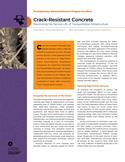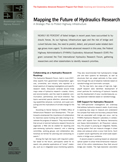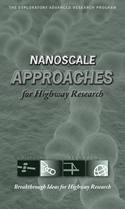U.S. Department of Transportation
Federal Highway Administration
1200 New Jersey Avenue, SE
Washington, DC 20590
202-366-4000
Focus
| Accelerating Infrastructure Innovations |
Publication Number: FHWA-HRT-10-014
Date: June 2010
From crack resistant concrete to hydraulics research, the Federal Highway Administration's (FHWA) Exploratory Advanced Research (EAR) Program focuses on long-term, high-risk research with a high payoff potential. The program addresses underlying gaps faced by applied highway research programs, anticipates emerging issues with national implications, and reflects broad transportation industry goals and objectives.
A series of EAR Program publications highlights the ongoing research projects. Publications now available online include:
 Crack Resistant Concrete: Maximizing the Service Life of Transportation Infrastructure (Pub. No. FHWA-HRT-09-065)-Cracking that leads to deterioration such as corrosion shortens the service lives of concrete bridges, tunnels, and pavements worldwide and reduces their level of performance. "High-Performance Stress-Relaxing Cementitious Composites for Crack-Free Pavements and Transportation Structures" is an EAR Program project launched in 2008 with the goal of designing concrete with increased resistance to cracking. The research is being conducted at Texas A&M University's Texas Transportation Institute. One method proposed introduces controlled cracking on a nano to micrometer scale to lower the tensile stresses in concrete to a level where they will not cause macroscale cracking or curling. This lowering of tensile stresses would be induced by using stress-relaxing cementitious composites. To download the fact sheet, visit www.fhwa.dot.gov/advancedresearch/pubs/09065.cfm.
Crack Resistant Concrete: Maximizing the Service Life of Transportation Infrastructure (Pub. No. FHWA-HRT-09-065)-Cracking that leads to deterioration such as corrosion shortens the service lives of concrete bridges, tunnels, and pavements worldwide and reduces their level of performance. "High-Performance Stress-Relaxing Cementitious Composites for Crack-Free Pavements and Transportation Structures" is an EAR Program project launched in 2008 with the goal of designing concrete with increased resistance to cracking. The research is being conducted at Texas A&M University's Texas Transportation Institute. One method proposed introduces controlled cracking on a nano to micrometer scale to lower the tensile stresses in concrete to a level where they will not cause macroscale cracking or curling. This lowering of tensile stresses would be induced by using stress-relaxing cementitious composites. To download the fact sheet, visit www.fhwa.dot.gov/advancedresearch/pubs/09065.cfm.
 Mapping the Future of Hydraulics Research: A Strategic Plan to Protect Highway Infrastructure (Pub. No. FHWA-HRT-10-034)-As highway infrastructure ages and the risk of bridge and culvert failures rises, the need to predict, detect, and prevent water-related damage grows more urgent. With EAR Program support, FHWA convened the First International Hydraulics Research Forum in 2007, which brought experts together to report on a broad spectrum of ongoing investigations and research needs. The EAR Program has also sponsored research on new ways to measure and understand the complex flow fields and boundary pressure fields associated with bridge pier scour, as well as investigated the development of an advanced optical system to allow three-dimensional measurement of the entire instantaneous flow field around bridge pier models. The fact sheet is available at www.fhwa.dot.gov/advancedresearch/pubs/10034/index.cfm.
Mapping the Future of Hydraulics Research: A Strategic Plan to Protect Highway Infrastructure (Pub. No. FHWA-HRT-10-034)-As highway infrastructure ages and the risk of bridge and culvert failures rises, the need to predict, detect, and prevent water-related damage grows more urgent. With EAR Program support, FHWA convened the First International Hydraulics Research Forum in 2007, which brought experts together to report on a broad spectrum of ongoing investigations and research needs. The EAR Program has also sponsored research on new ways to measure and understand the complex flow fields and boundary pressure fields associated with bridge pier scour, as well as investigated the development of an advanced optical system to allow three-dimensional measurement of the entire instantaneous flow field around bridge pier models. The fact sheet is available at www.fhwa.dot.gov/advancedresearch/pubs/10034/index.cfm.
 Nanoscale Approaches for Highway Research (Pub. No. FHWA-HRT-10-033)-Less than one-tenth of 1 percent of the $1.5 billion spent annually on nanoscale research by the Federal Government is directly related to highway research. In March 2009 the EAR Program sponsored a workshop to advance strategic investment in nanoscale research. Experts from academia and the Federal Government shared their understanding of nanoscale research and discussed key highway research issues in the areas of infrastructure, safety, operations, and the environment. To download this booklet, visit www.fhwa.dot.gov/advancedresearch/pubs/10033/index.cfm.
Nanoscale Approaches for Highway Research (Pub. No. FHWA-HRT-10-033)-Less than one-tenth of 1 percent of the $1.5 billion spent annually on nanoscale research by the Federal Government is directly related to highway research. In March 2009 the EAR Program sponsored a workshop to advance strategic investment in nanoscale research. Experts from academia and the Federal Government shared their understanding of nanoscale research and discussed key highway research issues in the areas of infrastructure, safety, operations, and the environment. To download this booklet, visit www.fhwa.dot.gov/advancedresearch/pubs/10033/index.cfm.
Additional EAR Program projects recently launched include "Nanoscale Approaches for Inhibiting Corrosion." Led by Florida State University, this project seeks to develop technologies for new in-situ materials and methods for repairing or retrofitting structures to inhibit corrosion. Also recently launched was "Intelligent Self-Sensing Concrete Pavement." Conducted by the University of Minnesota, Duluth, the project aims to develop new intelligent self-sensing concrete pavement that can monitor its own structural health by continuously detecting internal stress level changes. The research will be accomplished in partnership with the Minnesota Department of Transportation.
To learn more about the EAR Program, visit the Exploratory Advanced Research Web site at www.fhwa.dot.gov/advancedresearch. The site features information on research solicitations, updates on ongoing research, links to published materials, summaries of past EAR Program events, and details on upcoming events. For additional information, contact David Kuehn at FHWA, 202-493-3414 (email: david.kuehn@fhwa.dot.gov), or Terry Halkyard at FHWA, 202-493-3467 (email: terry.halkyard@fhwa.dot.gov).